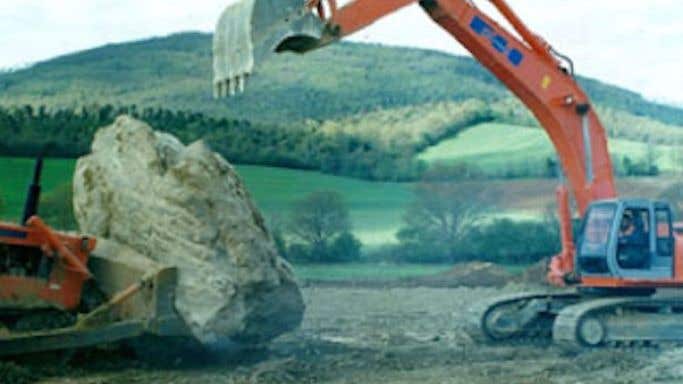From €11.90, £14.95, 16.50 Swiss francs, $16.99, CA$22.40, 2,494 yen
When in 1998 Paolo Baratta, former Italian politician and once president of the Venice Biennale, found the site he felt was right for the wine estate he had been dreaming of, some re-landscaping was in order. As he explains, ‘The diggers encountered some gigantic boulders. We gently extracted them and, due to their monumental beauty, we decided to place them along the alleys and between the vineyards, standing out like guardians. Naturally, they have become the symbol of the estate.’
Monteti is in the far south of the Maremma south of Monte Argentario and Grosseto and is named after the local mountain that is described as sheltering the vineyards from the coastal breezes – although I would have thought in a southern Tuscan summer one might be grateful for a sea breeze or two. The land was razed so as to keep the gradient to under seven per cent and the 25 hectares (62 acres) of vineyard then planted with a dense 6,500 plants in each separate one-hectare plot, designed to be vinified separately in their no-expense-spared winery. Popular oenologist Carlo Ferrini nursed the project along and, after detailed soil analysis, advised Baratta to plant the four major Bordeaux red wine grapes plus Alicante Bouschet.
The Maremma has proved it is one of the world’s key spots for answers to red bordeaux, as the likes of Ornellaia and Sassicaia have proved. (I just tasted Sassicaia 2013, the latest vintage, and much look forward to a vertical of Ornellaia’s Merlot, Masseto, next month.) I have heard it argued that all of the best regions for Cabernet Sauvignon are on west coasts: Bordeaux, Maremma, Margaret River, Napa Valley (give or take a coastal range in the last case).
The Monteti estate makes just two wines. The more expensive one is called simply Monteti and gets the full barrique ageing. The other one, which Baratta refuses to call a second wine, is this one, Caburnio. It came about its name, according to the estate’s website, ‘after a spelling mistake in the transcription of a passage of the Natural History by Pliny the Elder, written between 23 and 79 AD, in which, in the illustration of wine growing in Roman times in the province of Gallia Narbonensis [modern Narbonne], vitis Caburnicam appeared by mistake instead of Narbonicam, Narbonensis: “In the last seven years, a vine which buds in a single day and is therefore very strong, has been introduced in Alba Helvia; it is called Caburnicam and is planted today all over the province.” ‘
This seems to raise several questions. Which variety was this vine? Surely not any of those grown today in Bordeaux. And certainly not Alicante Bouschet, which was bred only in the middle of the nineteenth century. And why on earth was it called Caburnicam instead of Narbonicam?

Anyway, this less expensive offering from Monteti is made of Cabernet Sauvignon (from 50 to 60% depending on the vintage), Alicante Bouschet (20-30%) and Merlot (10-20%) and occasionally a little Petit Verdot and Cabernet Franc. Half the wine is aged in stainless steel and the other half in barriques and tonneaux made of medium-toasted French oak, of which a quarter to a third are new.
I tasted both the Caburnio 2011 and Monteti 2011, from a particularly hot vintage in Tuscany, at Lea & Sandeman’s autumn tasting and gave them both the same score, 16.5, even though the Monteti costs almost twice as much as the Caburnio. They are both very good wines, with admirable freshness as well as ripeness, but the Caburnio is already a delight – showing some attractive evolution on the nose with really exciting ripeness and character on the palate. It seems extremely good value to me, of interest to those looking for the extra zest that a really good Maremma wine can bring to the Bordeaux blend formula. The Petit Verdot-dominated Monteti is also very successful but I would keep it a bit longer before drinking it between 2017 and 2023 whereas I suggest 2014 to 2019 as the drinking period of Caburnio, which is 14% alcohol.
According to Wine-searcher, the wine is currently available in Britain (at Lea & Sandeman, who charge only £13.50 per bottle if it is bought as part of a mixed case), Austria, Switzerland, Italy, Netherlands, US, Quebec and Japan.
I am clearly very boring – or this wine is consistently good value – since the 2005 was also a wine of the week.

